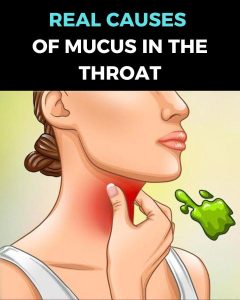Phlegm – it might sound gross, but this sticky substance plays a crucial role in protecting your body, and believe it or not, you produce enough of it each day to fill half of a two-liter soda bottle. Surprising? Maybe. But understanding how phlegm works and how to manage excess buildup can help you feel better and breathe easier, especially when you’re under the weather.

If you’re dealing with too much phlegm and looking for relief, the good news is there are several effective ways to reduce mucus production and support your respiratory health.
So, what exactly is phlegm? It’s a specific kind of mucus made by your respiratory tract—thicker and stickier than the mucus in your nose. Phlegm is designed to trap irritants like dust, bacteria, and allergens that you inhale, acting as a protective barrier inside your airways. According to the Cleveland Clinic, your body produces phlegm naturally every day to fight off inflammation and defend your lungs.
“While no one knows exactly how much phlegm the average person produces, most experts believe it’s about one liter daily,” says Dr. Paul C. Bryson, a laryngologist. That’s roughly half of a two-liter bottle of soda—every single day. And when you’re healthy, your body clears it without you even noticing.
But when you’re sick, things change. Phlegm production can ramp up, becoming thicker and more noticeable. It’s your body’s way of going into overdrive to fight off illness. While this response is natural, the resulting congestion and discomfort can be frustrating. Fortunately, there are ways to thin out phlegm, promote drainage, and make breathing easier.
Stay Hydrated
One of the simplest and most effective strategies is to stay hydrated. Drinking plenty of fluids helps thin mucus, making it less sticky and easier to clear from your throat and chest. Water, herbal teas, and clear broths are all excellent choices. Dr. Bryson offers an easy rule of thumb: “Drink enough water so your urine is pale.”
Why hydration works:
- Thins mucus: Water helps break down thick phlegm, allowing it to move more freely through your airways.
- Improves circulation: Good hydration supports overall body function, including a healthy respiratory system.
Steam Therapy
Inhaling steam is another great way to loosen stubborn mucus and open up your airways. Steam adds moisture to dry nasal passages, helping phlegm to flow and clear out more easily.
How to try it:
- Boil water and pour it into a heat-safe bowl.
- Add a few drops of eucalyptus or peppermint essential oil for added relief.
- Drape a towel over your head and inhale the steam for about 10 minutes.
Quick tip: No time for a full steam session? A hot shower can provide similar benefits, loosening mucus while you relax.
Gargle with Salt Water
Saltwater gargles are a tried-and-true home remedy that can soothe an irritated throat and help clear mucus. It’s easy, quick, and effective.
What to do:
- Dissolve half a teaspoon of salt into a glass of warm water.
- Gargle for 30 seconds, making sure the solution reaches the back of your throat.
- Spit it out and repeat several times throughout the day.
Over-the-Counter Relief
For those seeking faster results, over-the-counter medications may help. Decongestants and expectorants are two types of products designed to relieve mucus buildup.
- Decongestants shrink swollen nasal tissues, helping open up your nasal passages.
- Expectorants like guaifenesin help thin and loosen mucus so it’s easier to expel.
Before using any medications, especially if you have underlying health concerns, it’s wise to consult a healthcare professional.
Herbal Remedies
Nature has long provided relief for respiratory issues. Several herbs are known for their mucus-busting properties, including thyme, eucalyptus, and marshmallow root.
Ways to use them:
- Use eucalyptus essential oil in a diffuser or apply a balm to your chest.
- Brew fresh or dried thyme in hot water, strain, and sip as a tea.
- Try licorice root lozenges to soothe your throat and ease irritation.
Use a Humidifier
Adding moisture to the air can help reduce phlegm and prevent your airways from drying out. A cool mist humidifier is an excellent tool for this purpose.
Pro tip: Be sure to clean the humidifier regularly, following the manufacturer’s guidelines to avoid mold or bacteria buildup, which could worsen respiratory symptoms.
Flush Out Irritants
Nasal irrigation, such as using a neti pot with a saline solution, can be an effective way to flush out irritants and clear nasal passages. Saline rinses remove allergens, dust, and thick mucus, offering quick relief.
This method is especially helpful if your environment is dry or if you’ve been dehydrated, both of which can cause phlegm to become thicker and more difficult to manage.
Clean Your Environment
Allergens like dust, pet dander, and pollen can increase mucus production. Keeping your living space clean can make a significant difference in how much phlegm your body produces.
Cleaning tips:
- Replace or clean HVAC filters regularly.
- Vacuum carpets and furniture frequently.
- Wash bedding weekly in hot water.
- Use an air purifier to reduce airborne particles.
Phlegm might not be a popular topic of conversation, but it plays a key role in your health. From capturing irritants to signaling illness, this gooey substance is more than just an inconvenience—it’s your body’s frontline defense. By taking steps to manage phlegm, you can support your respiratory system and feel more comfortable day to day.
Did you realize phlegm worked so hard to keep you healthy? Let us know your thoughts—and be sure to share this article so others can learn too!





